Dynabook DCE45202A Tri-Mode Dual Band Analog/PCS Phone User Manual
Toshiba Corporation Tri-Mode Dual Band Analog/PCS Phone
Dynabook >
User Manual

CDM-9200X
OWNER'S OPERATING MANUAL
Draft
Nov. 2001
TABLE OF CONTENTS
SAFETY INFORMATION FOR WIRELESS
HANDHELD PHONES .......................................................... 1
SAR INFORMATION.............................................................. 2
HANDSET DESCRIPTION .................................................... 3
Function of Keys ................................................................. 4
GETTING STARTED ............................................................. 5
Placing Calls .....................…................................................ 6
Receiving Calls ...................….............................................. 7
OPERATING PROCEDURES …............................................ 8
APPLICANT: TOSHIBA CORPORATION
TRANSCEIVER TYPE: CJ6DCE45202A
EXHIBIT Type "User Manual"

SAFETY INFORMATION FOR
WIRELESS HANDHELD PHONES
SAFETY INFORMATION FOR
WIRELESS HANDHELD PHONES
Read this information before using your handheld
portable Cellular Telephone.
Your wireless handheld portable telephone is a low
power radio transmitter and receiver. When it is ON, it
receives and also sends out radio frequency (RF) sig-
nals.
FCC RF EXPOSURE INFORMATION
In August 1996, the Federal Communications Commis-
sion (FCC) of the United States, with its action in Re-
port and Order FCC 96-326, adopted an updated safety
standard for human exposure to radio frequency (RF)
electromagnetic energy emitted by FCC regulated trans-
mitters. Those guidelines are consistent with the safety
standard previously set by both U.S. and international
standards bodies. The design of this phone complies
with the FCC guidelines and these international stan-
dards.
Use only the supplied or an approved antenna. Unau-
thorized antennas, damaged antennas, modifications,
or attachments could impair call quality, damage the
phone, or result in violation of FCC regulations. Please
contact your local dealer for replacement antenna.
Body-worn Operation
This device was tested for typical body-worn operations
with the BC-9200 belt-clip,
offered by Audiovox as an accessory to this phone,
and found to comply with FCC RF exposure require-
ments. Third-party belt-clips, holsters and similar ac-
cessories should be avoided, as they have not been
tested and may not comply with FCC RF exposure lim-
its.
For more information about RF exposure, please visit
the FCC website at www.fcc.gov .
11

phones used by the public is 1.6 watts/kg (W/kg) averaged
over one gram of tissue. The standard incorporates a sub-
stantial margin of safety to give additional protection for the
public and to account for any variations in measurements.
SAR INFORMATION
SAR INFORMATION
THIS MODEL PHONE MEETS THE GOVERNMENT’S RE-
QUIREMENTS FOR EXPOSURE TO RADIO WAVES.
Your wireless phone is a radio transmitter and receiver. It is
designed and manufactured not to exceed the emission limits
for exposure to radiofrequency (RF) energy set by the Fed-
eral Communications Commission of the U.S. Government.
These limits are part of comprehensive guidelines and estab-
lish permitted levels of RF energy for the general population.
The guidelines are based on standards that were developed
by independent scientific organizations through periodic and
thorough evaluation of scientific studies. The standards include
a substantial safety margin designed to assure the safety of
all persons, regardless of age and health.
The exposure standard for wireless mobile phones employs a
unit of measurement known as the Specific Absorption Rate,
or SAR. The SAR limit set by the FCC is 1.6 W/kg.* Tests for
SAR are conducted with the phone transmitting at its highest
certified power level in all tested frequency bands. Although the
SAR is determined at the highest certified power level, the ac-
tual SAR level of the phone while operating can be well below
the maximum value. This is because the phone is designed to
operate at multiple power levels so as to use only the power
required to reach the network. In general, the closer you are to
a wireless base station antenna, the lower the power output.
Before a phone model is available for sale to the public, it
must be tested and certified to the FCC that it does not ex-
ceed the limit established by the government-adopted require-
ment for safe exposure. The tests are performed in positions
and locations (e.g., at the ear and worn on the body) as re-
quired by the FCC for each model. The highest SAR value for
this model phone when tested for use at the ear is 1.34 W/kg
and when worn on the body, as described in this user guide,
is 1.32 W/kg. (Body-worn measurements differ among phone
models, depending upon available accessories and FCC re-
quirements). While there may be differences between the SAR
levels of various phones and at various positions, they all meet
the government requirement for safe exposure.
The FCC has granted an Equipment Authorization for this
model phone with all reported SAR levels evaluated as in com-
pliance with the FCC RF exposure guidelines. SAR informa-
tion on this model phone is on file with the FCC and can be
found under the Display Grant section of http://www.fcc.gov/
oet/fccid after searching on FCC ID CJ6DCE45202A.
Additional information on Specific Absorption Rates (SAR) can
be found on the Cellular Telecommunications & Internet As-
sociation (CTIA) web-site at http://phonefacts.net.
*In the United States and Canada, the SAR limit for mobile
2
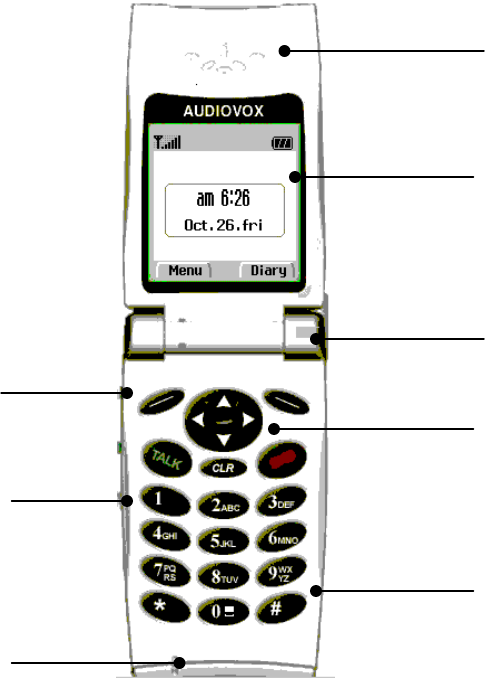
HANDSET DESCRIPTION
Volume Button
VAD Button
Earpiece
LCD Screen
LED
Function Keys
Keypad
Microphone
3
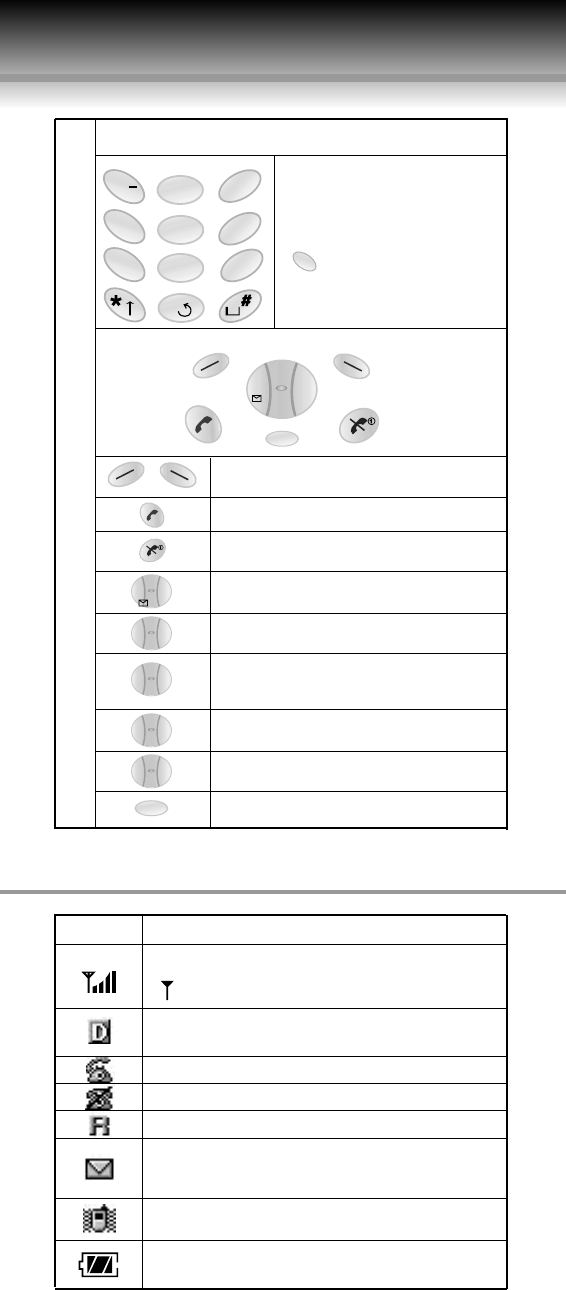
Function of Keys
LCD Display Indication
Digit Keys
Function Keys
4GHI
7PQRS
2ABC
5JKL
8TUV
3DEF
6MON
9WXYZ
To enter Telephone Numbers.
To enter letters and symbols
is also used for One-Touch
Emergency feature.
Key - Board Arrangement
1ABC
CLR
Soft keys. To function as shown in the bottom line
on the display.
SEND keys. To originate or receive a Call.
END keys. To terminate a Call and to turn the
phone ON/OFF.
Receiving Signal Stengh Indicator.
The number of lines indicates the received Signal Strengh, and
is also used as a POWER ON Indicator.
Digital Mode Indicator.
To indicate the phone is operating in digital mode.
Meessage Indicator. To indicate that new Text Messages
are stored in memory or new Voice Messages are in your
Voice Mailbox.
Vibrating Indicator. To indicate that the vibrating alert is
active.
Battery Indicator.
Monitors the battery charge condition.
A Call is in progress.
The phone is out of Service Area.
The phone is out of the home Area.
To readout Text Message or Voice Mail Notification.
Also used as Left-arrow key.
To recall phone numbers from memory.
Also used as Left-arrow key.
Used as Up/Down-arrow keys.
Wap.
Call history.
To clear digits from the display or from a memory
location.
CLR
Items Descriptions
0
1@
̈
̇
̄
̆
̈
̇
̄
̄
̆
̆
4
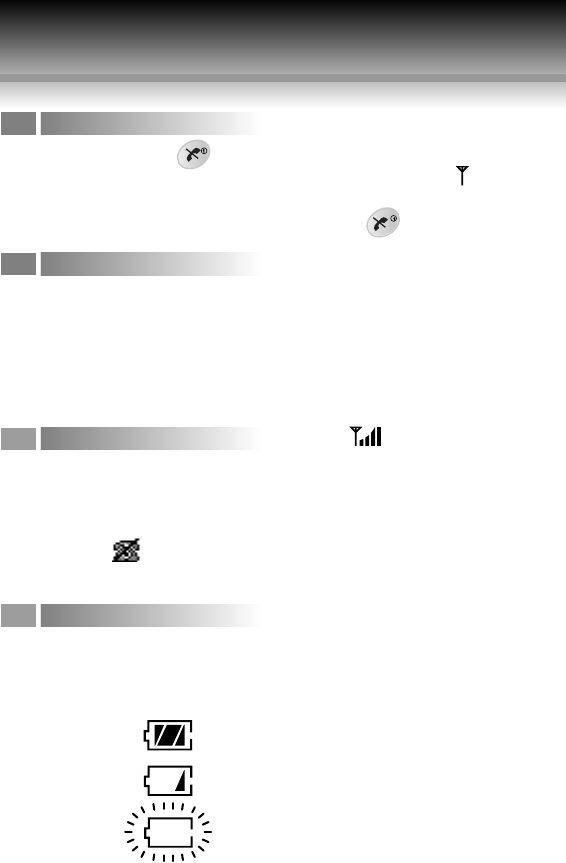
GETTING STARTED
Press and hold [ ]. All the indicators and the display will light
momentarily, and a tone will be heard. The indicator will be
displayed while the phone is on.
Antenna Position
The antenna can be used in its fully extended or fully retracted
position only. It is recommended that the antenna should be fully
extended for optimum performance and signal strength or while
operating in poor signal areas.
Receiving Signal Strength Indicator ( )
The number of lines indicates the Signal Strength in your area.
Four lines show the maximum level. The display will vary as you
move with the phone. If the signal is not strong enough to place
a call. will appear on the LCD dispaly.
Battery Level Indicator
You can always monitor the battery charge condition with the
constant battery level indicator. The number of blocks indicates
the battery conditions as follows;
Turning the Phone On/Off
Full charge
Low charge
Flashing indicates discharged.
To turn the phone off, press and hold [ ].
5
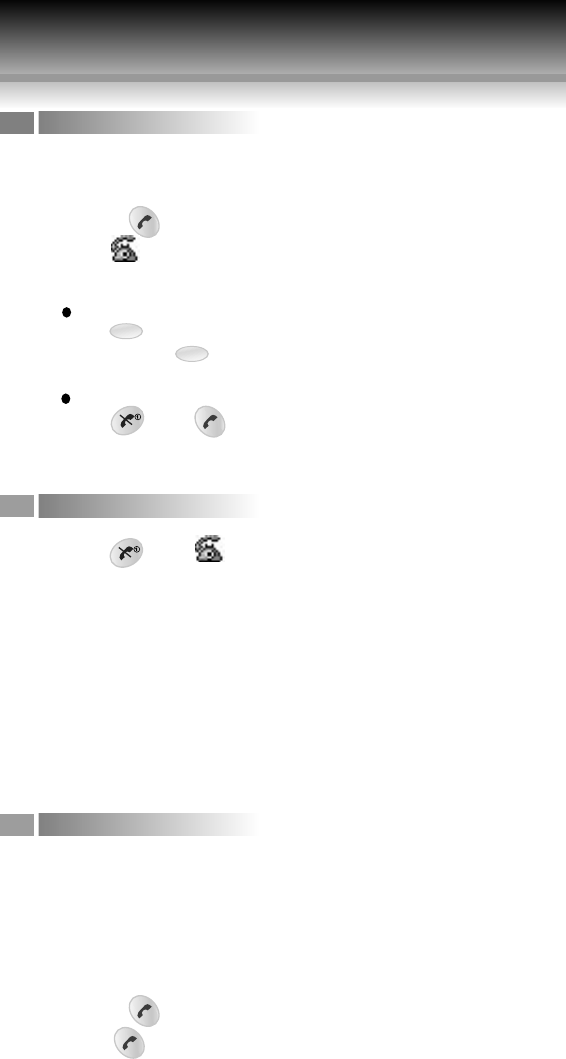
Placing Calls
To Place a Calls
Speed Dialing
If you know the phonebook address of the telephone number
that you want to call.
1. Enter the one or two digits of your Phonebook address (1 to 9
or 10 to 99).
2. Press [ ]. The phone number will be displayed.
The [ ] indicator will light, and the call will be placed.
CLR
CLR
1. Enter the phone number.
(A maximum of 32 digits will be displayed.)
2. Press [ ].
The indicator will light.
To Corrert a Number
Press to clear the last digit.
Press and hold to erase all the digits entered.
If the Call Fails to Go through
Press [ ] and [ ] to redial the number.
To Terminate a Call
Press [ ]. The indicator will go out.
6
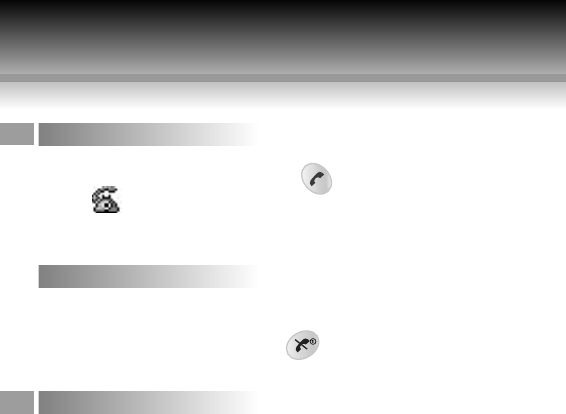
Receiving Calls
Caller ID with Name
This feature allows you to preview in your display the number
and name of the party calling you before you answer the call.
The name is as you programmed it in your phonebook.
1. When the phone rings, the
Calling Number appears in
the display.
2. The last 10 Caller IDs are stored in the memory for your
review and redial.
To Receive a Call
When the telephone rings, press [ ] to answer the call.
The indicator will light.
Any Key Answering
This feature permits you to answer an incoming call by pressing
any key on the key pad except [ ].
7
OPERATING PROCEDURESOPERATING PROCEDURES
Never violate any of the following Rules and Regula-
tions of the FCC when using your Cellular Phone. Such
violations are punishable by fine, imprisonment or both.
•Never use obscene, indecent, or profane lan-
guage.
•Never use your Cellular Phone to send false dis-
tress calls.
•Never wiretap or otherwise intercept a phone call,
unless you have first obtained the consent of the
parties participating in the call.
•Never make any anonymous calls to annoy, ha-
rass, or molest other people.
•Never charge another account without authoriza-
tion, to avoid payment for service.
•Never willfully or maliciously interfere with any
other radio communications.
•Never refuse to yield the line when informed that
it is needed for an Emergency Call. Also, never
take over a line by stating falsely that it is needed
for an emergency.
8